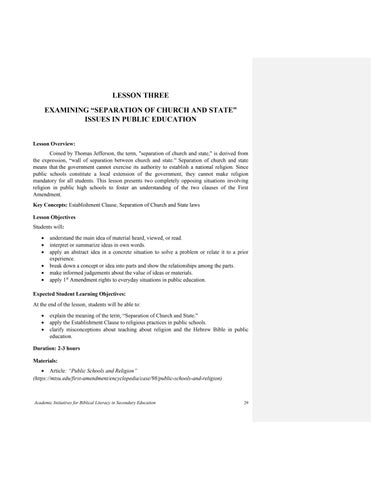LESSON THREE EXAMINING “SEPARATION OF CHURCH AND STATE” ISSUES IN PUBLIC EDUCATION
Lesson Overview: Coined by Thomas Jefferson, the term, "separation of church and state," is derived from the expression, “wall of separation between church and state.” Separation of church and state means that the government cannot exercise its authority to establish a national religion. Since public schools constitute a local extension of the government, they cannot make religion mandatory for all students. This lesson presents two completely opposing situations involving religion in public high schools to foster an understanding of the two clauses of the First Amendment. Key Concepts: Establishment Clause, Separation of Church and State laws Lesson Objectives Students will: • • • • • •
understand the main idea of material heard, viewed, or read. interpret or summarize ideas in own words. apply an abstract idea in a concrete situation to solve a problem or relate it to a prior experience. break down a concept or idea into parts and show the relationships among the parts. make informed judgements about the value of ideas or materials. apply 1st Amendment rights to everyday situations in public education.
Expected Student Learning Objectives: At the end of the lesson, students will be able to: • • •
explain the meaning of the term, “Separation of Church and State.” apply the Establishment Clause to religious practices in public schools. clarify misconceptions about teaching about religion and the Hebrew Bible in public education.
Duration: 2-3 hours Materials: • Article: “Public Schools and Religion” (https://mtsu.edu/first-amendment/encyclopedia/case/98/public-schools-and-religion)
Academic Initiatives for Biblical Literacy in Secondary Education
29

